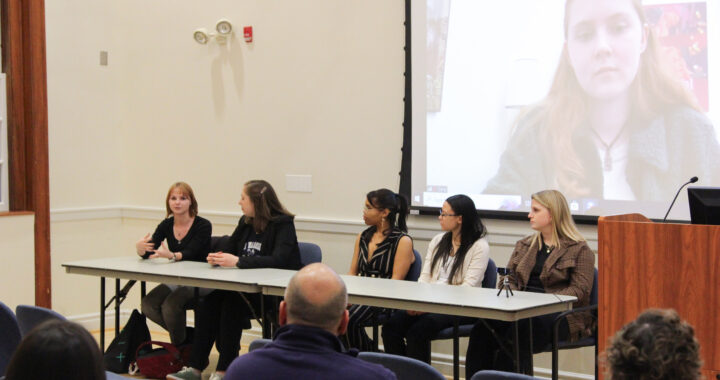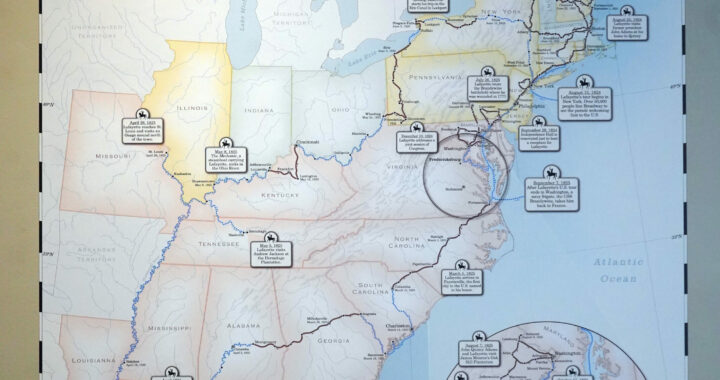Social media post prompts safety alert from UMW PD after trespassing incident
4 min read
On Feb. 24 and 25, a unmasked man with no connection to UMW followed and intimidated students, trying to enter Willard Hall and successfully entering the performing arts building. | University Police
by ERIN MATUCZINSKI
Business Editor
On Feb. 25, around 8 p.m., messages began circulating on students’ Instagram accounts warning others that there was a man stalking girls on campus. The man was not pictured, just a wall of text describing his appearance and actions, including his attempt to enter Willard Hall.
“If anyone sees a man wearing a grey shirt with a red flannel overtop in his late 20s – early 30s about 6 feet tall with dirty blonde/brown hair… Campus Police asked us to let people know and to have you guys call if you see him.”
As the message was shared on multiple students’ accounts, the campus community started to wonder why the police were not putting out an official message. After all, under the Jeanne Clery Act, they are required to give timely notifications about potential threats of violence.
It was not until the following day, Feb. 26, that University Police sent an email in accordance with the Broadcast Email Policy reiterating the information about an intruder on campus, along with security camera photos. In a follow-up email later that night, it was stated that the man returned to campus that evening, where he was confronted by UMW PD and issued a trespass notice.
The episode continued to harbor confusion amongst students as to why social media had been so far ahead of the police in informing the public. A Blue & Gray Press investigation found that police waited to send a safety alert because of their obligation to follow ethical considerations around such alerts, and they did not yet have enough information to send out a proper, federal-compliant message.
“At the time, the information that came in was spotty,” said Chief of Police Michael Hall. “Had I had more details or more information, then a timely warning would have went out then.”
While the received messages may look similar, there is a difference between campus safety alerts and timely warnings. Safety alerts are used more often, as their purpose is to make the community aware of a situation that may be of concern, but do not impose immediate danger. Timely warnings are used during imminent threats to the community and give instructions to recipients, such as the shelter-in-place that was implemented during the Nov. 2019 gun threat incident.
The person of interest, whose name has not been released, was reported to have first appeared on campus on the evening of Feb. 24. He approached female freshman students, asking them how to get into Willard Hall. The students described him as “disoriented” and called the non-emergency police line after their uncomfortable interaction.
The man returned on the evening of Feb. 25, the night that warnings began circulating on social media. The UMW Crime Log noted a trespassing incident at Seacobeck Hall at 8:01 p.m., less than an hour before the man attempted to enter Willard Hall again, but it is unclear
“We sent out a message as soon as we realized the person showed up on consecutive days,” said Anna Billingsley, associate vice president of University Relations. “The message to the community – a safety alert, not a timely warning – was to serve two purposes: to make the community aware of a suspicious person and to clarify misinformation that was on social media.”
The Threat Assessment Team (TAT), a group of faculty and staff members that meets regularly and as needed to assess possible threats to campus, did meet in response to this situation. However, due to Virginia law, all TAT meetings are closed and any documents are not reviewable by the public.
In the past, some students have questioned why they are not allowed to have seats on the TAT. Vice President of Student Affairs Juliette Landphair resonates with this inquiry, as she feels that bringing student voices in wherever possible is best. But because TAT already has members designated by the state and often reviews protected student information, no student representatives are permitted on the team. The current thirteen sitting members must act in what they think is the best interest of students.
“There is absolutely a commitment to transparency,” said Landphair. “Now, I do want to add that there are all sorts of other obligations around: need to notify, or sometimes the police will have to make decisions about how much information to release that would prove less helpful than not in their case in trying to find a perpetrator.”
Since the Virginia Tech mass shooting in 2007, there are now fewer steps in the process of warning the community of danger in order to save time. For example, if the police were to receive credible word of an active shooter on campus, a communications officer can immediately send a campus-wide warning through sounding sirens and flashing alerts on campus screens. In the past, that action would have had to be approved by multiple people beforehand, possibly wasting time when it can be most precious.
There are also fill-in-the-blank “canned messages” on hand to continue to expedite the alert process, which can be used in less emergent situations as well, according to Hall. But there are no set guidelines as to what kinds of events may count for a timely warning versus a safety alert, just the level of danger they impose.
“A lot of times when it comes to timely warnings, there’s some black and white, but then there’s a lot of gray that you have to work through,” said Hall. “You have to balance the information that you’re putting out – will it create greater harm to the community?”
While the unnamed man has not been reported to be seen on campus since the safety alert update sent on Feb. 27, students continue to take their campus safety concerns to social media. For UMW Police, that means having to work fast enough to send alerts before the information is already spread.











